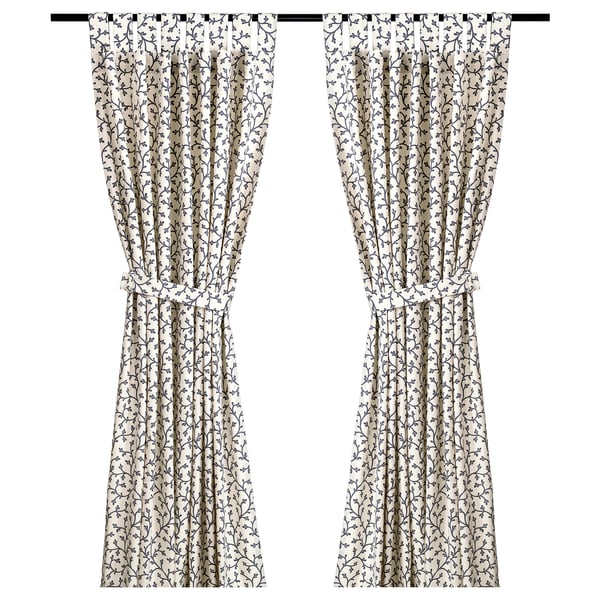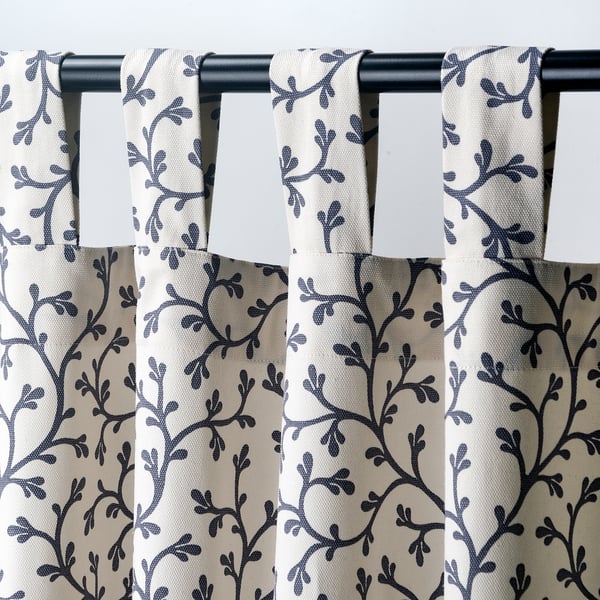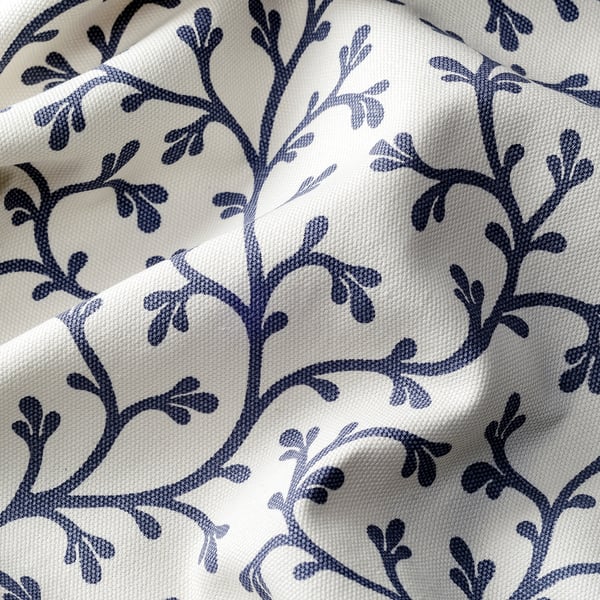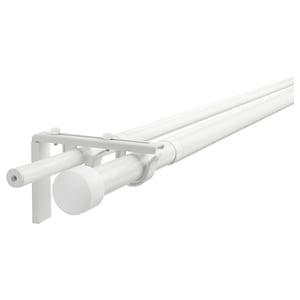The museum houses more than six million patterns, and you'll find some of them featured on our textiles. The floral patterns of SPRÄNGÖRT and HÄSSLEKLOCKA quilt covers and curtains; striped ULLAKARIN fabric; and vine-covered LUNGÖRT cushion cover, all come from the museum's archive, along with the designs for STENÖRT quilt cover and SIGBRITT fabric. The vast collection of swatches and samples at the museum is carefully stored in seemingly endless shelves, drawers and old books.
LUNGÖRT Curtains with tie-backs, 1 pair, white/grey/with tab top, 145x150 cm
Must be completed with
How to get it
- Light filtering
The curtains lower the general light level and provide privacy by preventing people outside from seeing directly into the room.
Product details
Tab top curtains have fabric loops that slide easily over the curtain rod for smooth opening and closing. Their distinctive look suits many different types of interiors.
The tab heading allows you to hang the curtains directly on a curtain rod.
Good to know
Curtain, 1 pair included.
The curtains are sold in pairs. The sizes stated refer to each single curtain. For the total width, double the width of a single curtain.
You can use SY iron-on hemming strip to shorten the curtains without sewing.
16 gliders and hooks are usually recommended for each curtain with a width of 145 cm. You can increase or decrease the number depending on whether you want narrower or fuller folds in the pleats.
Materials and care
Material
100% cotton
Care
Shrinkage maximum 4%.
Machine wash, max 40°C, normal process.
Do not bleach.
Tumble drying, normal temperature (max 80°C).
Iron, max 150°C.
Do not dryclean.
Measurements
- Length: 150 cm
- Width: 145 cm
- Weight: 1.30 kg
- Area: 2.18 m²
Packaging
LUNGÖRT
Article number004.182.15- Width: 27 cm
- Height: 4 cm
- Length: 38 cm
- Weight: 1.33 kg
- Package(s): 1
Reviews
Customer reviews
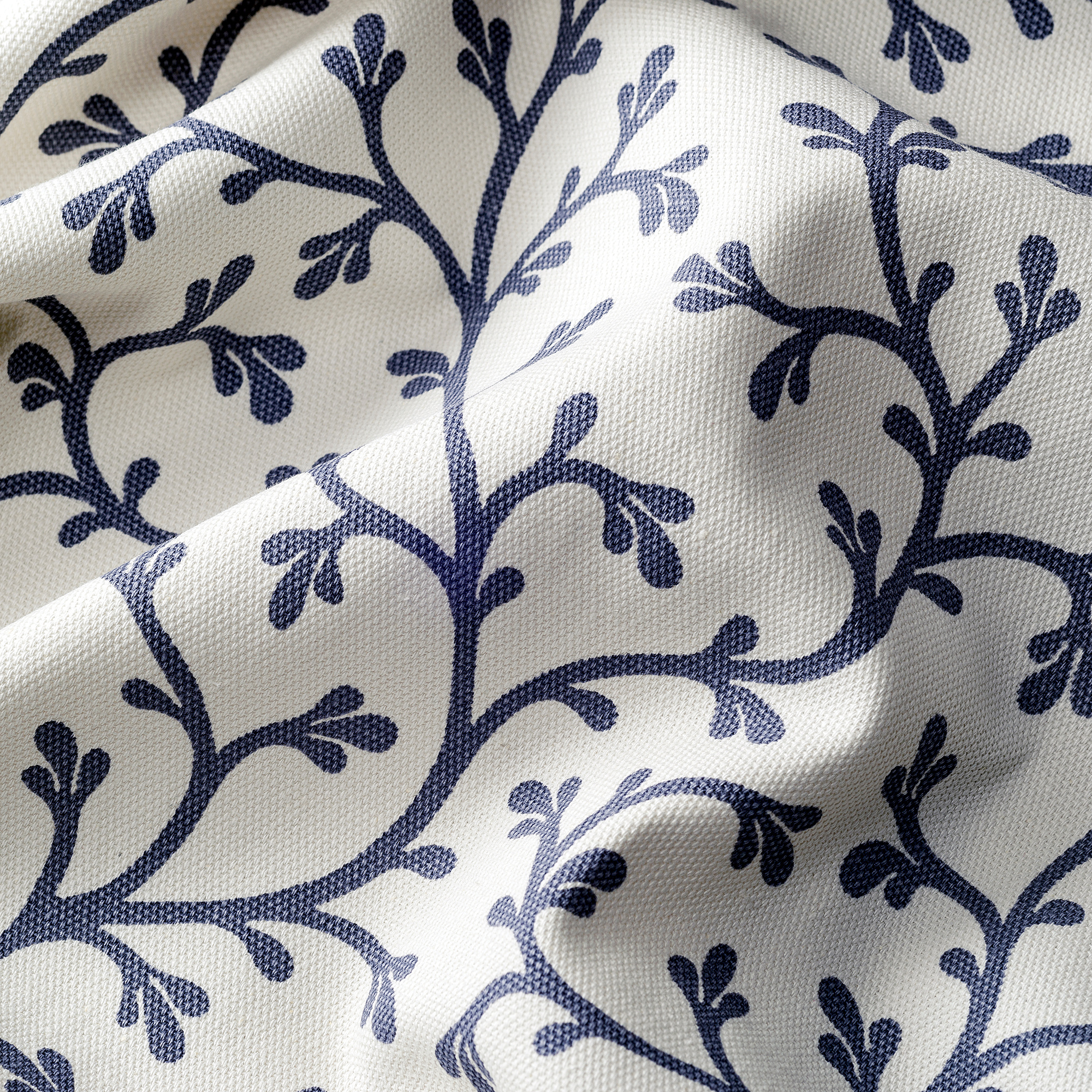
Textiles with patterns from the past
Today, more and more people are moving into cities. We're driven by rapid advancements in technology and a changing way of life. And though we live in an ever-changing world, many of us still have a longing for the familiar and a desire for the traditional. Like the patterns found on some of our textiles – inspired by 19:th century prints from a museum collection in France.
Musée de l'Impression sur Étoffes (Museum of Printed Textiles) is tucked away in the northeast corner of France. It was founded in the 19th century, a time characterised by fantastic innovations that opened up the world like never before. The parallels between that time and today are striking. Which is why it seems appropriate that, when some from our design team sought out inspiration for traditional textiles to suit our modern world, they turned here.
A treasure-chest of textiles
Inspiration through the times
"The museum is really fantastic," says Susanna Leo, one of our designers, and a driving force behind our textiles in this style. Visiting the museum and pouring over aging books filled with fabric swatches made her heart race. "They have so many nice patterns and they are timeless." David Soyer, who works at the museum, helps designers, artists and scholars who are looking for patterns from the past. He has worked with Susanna and some of her colleagues before, providing them with a multitude of samples over the years. "For us it is the opportunity to make the designs alive one more time," explains David. "For them it is an incredible and wealthy source of inspiration and a way to join history and culture to their creations."
Piecing it all together
The colours of the patterns are adjusted to coordinate with other IKEA products, but Susanna and her colleagues take care to change as little as possible in order to secure authenticity. Coordinating a textile collection to work not only together, but also with the furniture that already exists at IKEA, as well as considering the types of things people already have at home – is a huge challenge. “It’s a big puzzle actually,” says Emma Jones, who worked with Susanna to create the textiles. “A really big puzzle,” she laughs. Keeping the customer at the centre of their project was the key to creating the products. “This style can suit many different people in many different stages of their lives,” Emma says. “Even if you like this style, it doesn’t have to mean you’re old fashioned. You probably just appreciate quality that never goes out of style.”
Material
What is cotton?
Cotton is one of the world's most appreciated and used natural fibres. Textiles in cotton are soft, hardwearing and can be washed at high temperatures. They are also good at breathing and absorbing moisture – making them pleasant to wear close to the body. Today at IKEA we use more and more recycled cotton and strive to make sure that all the new cotton we use has been grown and produced with less and less amounts of pesticides, fertilisers and water.
Function solution
The fabric dims the daylight
The fabric dims the daylight entering the room when it is brighter outside, and reduces glare. It gives you a comfortable sense of privacy because people cannot see in during the daytime. At night, when the room is lit, it is possible to perceive shapes and silhouettes from outside.
